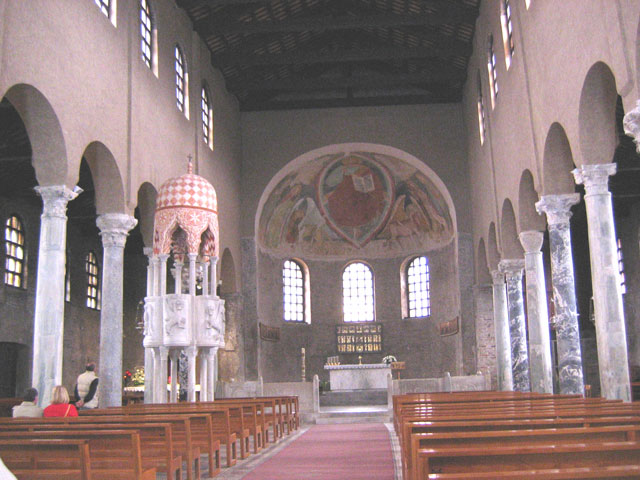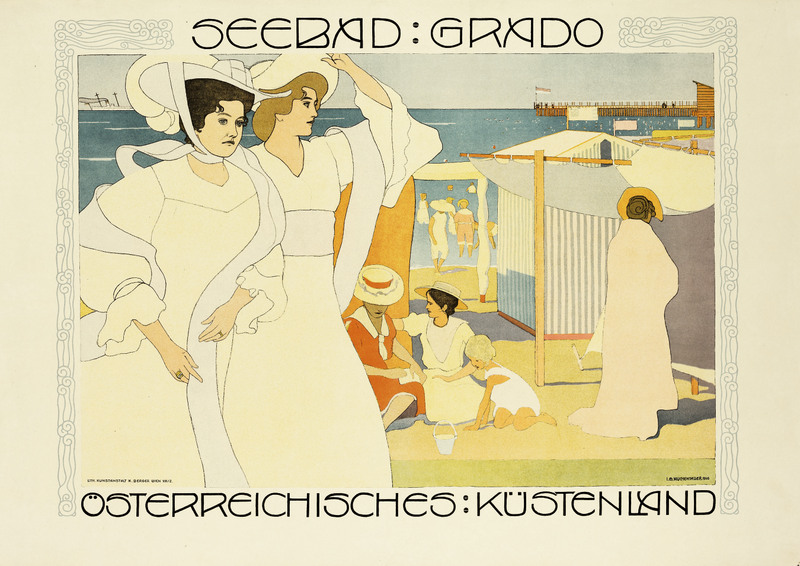|
Old-Aquileia
The Patriarchate of Old Aquileia existed between 607 and 698 because of the Tricapitoline Schism in the Patriarchate of Aquileia. It was allied with the Arian Lombards, while the rival Patriarchate of Grado was allied with the Byzantine Empire. Background The bishops under the patriarch of Aquileia had split with Rome when they refused to condemn theologians who had been condemned by the rest of the Church. After the Lombard invasion of Northern Italy they had fled to the island of Grado, then under control of the Byzantines, although for years they maintained the schism. In 606 the newly elected bishop reconciled with Rome. Split with Grado Many mainland bishops, whose dioceses were under Lombard control were unhappy with the reconciliation. These dissidents fled to mainland Aquileia and under Lombard protection elected a John as a rival patriarch who maintained the schism. There were now two patriarchates in northern Italy, Aquileia in Grado and Old-Aquileia. Thus, the ... [...More Info...] [...Related Items...] OR: [Wikipedia] [Google] [Baidu] |
Patriarchate Of Aquileia
The Patriarchate of Aquileia was an episcopal see in northeastern Italy, centred on the ancient city of Aquileia situated at the head of the Adriatic, on what is now the Italian seacoast. For many centuries it played an important part in history, particularly in that of the Holy See and northern Italy, and a number of Councils of Aquileia, church councils were held there. No longer a residential bishopric, it is today classified as an Titular Archbishop of Aquileia, archiepiscopal titular see. History From bishopric to patriarchate Ancient tradition asserts that the see was founded by St. Mark, sent there by St. Peter, prior to his mission to early centers of Christianity#Alexandria, Alexandria. St. Hermagoras is said to have been its first bishop and to have died a martyr's death (c. 70). At the end of the third century (285) another martyr, Hilarius of Aquileia, St. Helarus (or St. Hilarius), was bishop of Aquileia. In the course of the Christianity in the 4th century, four ... [...More Info...] [...Related Items...] OR: [Wikipedia] [Google] [Baidu] |
Schism Of The Three Chapters
The Schism of the Three Chapters was a schism that affected Chalcedonian Christianity in Northern Italy lasting from 553 to 698 AD, although the area out of communion with Rome contracted throughout that time. It was part of a larger Three-Chapter Controversy that affected the whole of Roman-Byzantine Christianity. Background to the Three-Chapter Controversy The Three-Chapter Controversy came out of an attempt to reconcile the Non-Chalcedonian (Miaphysite) Christians of the Middle East with the Chalcedonian Christianity, Chalcedonian Church. A major part of the attempted compromise was a condemnation of certain works of Eastern Christian writers such as Theodoret of Cyrus and Theodore of Mopsuestia which soon became known as the ''Three Chapters''. These were seen to be particularly objectionable by the opponents of the Council of Chalcedon and in an attempt to win them to the Council the condemnation was seen as a way of reassuring them. The condemnation took place as an Imperial ... [...More Info...] [...Related Items...] OR: [Wikipedia] [Google] [Baidu] |
Patriarch Of Grado
This is a list of the Patriarchs of Grado (north-eastern Italy). ''''. David M. Cheney. Retrieved September 25, 2016"Patriarchal See of Grado" ''GCatholic.org''. Gabriel Chow. Retrieved September 25, 2016 The patriarchate came into being when the schismatic , [...More Info...] [...Related Items...] OR: [Wikipedia] [Google] [Baidu] |
Patriarchate Of Grado
This is a list of the Patriarchs of Grado (north-eastern Italy). ''''. David M. Cheney. Retrieved September 25, 2016"Patriarchal See of Grado" ''GCatholic.org''. Gabriel Chow. Retrieved September 25, 2016 The patriarchate came into being when the schismatic , [...More Info...] [...Related Items...] OR: [Wikipedia] [Google] [Baidu] |
Aquileia In Grado
This is a list of the Patriarchs of Grado (north-eastern Italy). ''''. David M. Cheney. Retrieved September 25, 2016"Patriarchal See of Grado" ''GCatholic.org''. Gabriel Chow. Retrieved September 25, 2016 The patriarchate came into being when the schismatic , [...More Info...] [...Related Items...] OR: [Wikipedia] [Google] [Baidu] |
Island Of Grado
Grado ( vec, Gravo; fur, Grau; sl, Gradež; la, Gradus) is a town and ''comune'' of 8,064 residents in the north-eastern Italian region of Friuli-Venezia Giulia, located on an island and adjacent peninsula of the Adriatic Sea between Venice and Trieste. The territory of the municipality of Grado extends between the mouth of the Isonzo and the Adriatic Sea and the lagoon of the same name which covers an area of about 90 square kilometers and goes from Porto Buso to Fossalon. Characteristic of the lagoon is the presence of the '' casoni'', which are simple houses with thatched roof used in the past by the fishermen of Grado, who remained in the lagoon for a long time, returning to the island of Grado only during the colder period of the year. Once mainly a fishing centre, today it is a popular tourist destination, known commonly as ''L'Isola del Sole'' ("The Sunny Island"). It is also famous because it is a spa town; from 1873 a maritime hospice for children called Ospizio Mar ... [...More Info...] [...Related Items...] OR: [Wikipedia] [Google] [Baidu] |
Constantinople
la, Constantinopolis ota, قسطنطينيه , alternate_name = Byzantion (earlier Greek name), Nova Roma ("New Rome"), Miklagard/Miklagarth (Old Norse), Tsargrad ( Slavic), Qustantiniya (Arabic), Basileuousa ("Queen of Cities"), Megalopolis ("the Great City"), Πόλις ("the City"), Kostantiniyye or Konstantinopolis ( Turkish) , image = Byzantine Constantinople-en.png , alt = , caption = Map of Constantinople in the Byzantine period, corresponding to the modern-day Fatih district of Istanbul , map_type = Istanbul#Turkey Marmara#Turkey , map_alt = A map of Byzantine Istanbul. , map_size = 275 , map_caption = Constantinople was founded on the former site of the Greek colony of Byzantion, which today is known as Istanbul in Turkey. , coordinates = , location = Fatih, İstanbul, Turkey , region = Marmara Region , type = Imperial city , part_of = , length = , width ... [...More Info...] [...Related Items...] OR: [Wikipedia] [Google] [Baidu] |
Pallium
The pallium (derived from the Roman ''pallium'' or ''palla'', a woolen cloak; : ''pallia'') is an ecclesiastical vestment in the Catholic Church, originally peculiar to the pope, but for many centuries bestowed by the Holy See upon metropolitans and primates as a symbol of their conferred jurisdictional authorities, and still remains a papal emblem. In its present (western) form, the pallium is a long and "three fingers broad" (narrow) white band adornment, woven from the wool of lambs raised by Trappist monks. It is donned by looping its middle around one's neck, resting upon the chasuble and two dependent lappets over one's shoulders with tail-ends (doubled) on the left with the front end crossing over the rear. When observed from the front or rear the pallium sports a stylistic letter 'y' (contrasting against an unpatterned chasuble). It is decorated with six black crosses, one near each end and four spaced out around the neck loop. At times the pallium is embellished fore, ... [...More Info...] [...Related Items...] OR: [Wikipedia] [Google] [Baidu] |
Council Of Pavia (698)
The council of Pavia of 698 was an ecclesiastical synod convoked by King Cunincpert to end the schism of the Three Chapters in the Lombard kingdom. The principal source for the synod is a contemporary Latin poem commissioned by the king, the '' Song of the Synod of Pavia''.Michael Richter, ''Bobbio in the Early Middle Ages: The Abiding Legacy of Columbanus'' (Four Courts Press, 2008), 87. Although the council met in the Lombard capital of Pavia, two later sources—the ''History of the Lombards'' and the ''Liber Pontificalis''—erroneously place the council in Aquileia.Albrecht Berger (ed.), ''Life and Works of Saint Gregentios, Archbishop of Taphar: Introduction, Critical Edition and Translation'' (De Gruyter, 2006), 22. Albrecht Berger suggests that the 10th-century Greek ''Life'' of Gregentios may dimly allude to the council of Pavia when it reports a story about discussions between Arians Arianism ( grc-x-koine, Ἀρειανισμός, ) is a Christological doctrine fi ... [...More Info...] [...Related Items...] OR: [Wikipedia] [Google] [Baidu] |
Decline And Fall Of The Roman Empire
''The History of the Decline and Fall of the Roman Empire'' is a six-volume work by the English historian Edward Gibbon. It traces Western civilization (as well as the Islamic and Mongolian conquests) from the height of the Roman Empire to the fall of Byzantium in the fifteenth century. Volume I was published in 1776 and went through six printings. Volumes II and III were published in 1781; volumes IV, V, and VI in 1788–1789.The original volumes were published in quarto sections, a common publishing practice of the time. The six volumes cover the history, from 98 to 1590, of the Roman Empire, the history of early Christianity and then of the Roman State Church, and the history of Europe, and discusses the decline of the Roman Empire among other things. Thesis Gibbon offers an explanation for the fall of the Roman Empire, a task made difficult by a lack of comprehensive written sources, though he was not the only historian to attempt it. According to Gib ... [...More Info...] [...Related Items...] OR: [Wikipedia] [Google] [Baidu] |
Pope Honorius I
Pope Honorius I (died 12 October 638) was the bishop of Rome from 27 October 625 to his death. He was active in spreading Christianity among Anglo-Saxons and attempted to convince the Celts to calculate Easter in the Roman fashion. He is chiefly remembered for his correspondence with Patriarch Sergius I of Constantinople over the latter's monothelite teachings. Honorius was posthumously anathematized, initially for subscribing to monothelitism, and later only for failing to end it. The anathema against Honorius I became one of the central arguments against the doctrine of papal infallibility. Early life Honorius was a rich aristocrat who came from Campania. His father was the consul Petronius. Nothing is known about Honorius I's career before he became pope on 27 October 625. He was consecrated only two days after the death of his predecessor, Boniface V. The vacancy was short probably because of the presence in Rome of Isaac the Armenian, who was empowered to confirm the ... [...More Info...] [...Related Items...] OR: [Wikipedia] [Google] [Baidu] |
Edward Gibbon
Edward Gibbon (; 8 May 173716 January 1794) was an English historian, writer, and member of parliament. His most important work, ''The History of the Decline and Fall of the Roman Empire'', published in six volumes between 1776 and 1788, is known for the quality and irony of its prose, its use of primary sources, and its polemical criticism of organised religion. Early life: 1737–1752 Edward Gibbon was born in 1737, the son of Edward and Judith Gibbon at Lime Grove, in the town of Putney, Surrey. He had six siblings, five brothers and one sister, all of whom died in infancy. His grandfather, also named Edward, had lost his assets as a result of the South Sea bubble stock-market collapse in 1720 but eventually regained much of his wealth. Gibbon's father was thus able to inherit a substantial estate. One of his grandmothers, Catherine Acton, descended from Sir Walter Acton, 2nd Baronet. As a youth, Gibbon's health was under constant threat. He described himself as "a puny ... [...More Info...] [...Related Items...] OR: [Wikipedia] [Google] [Baidu] |





.djvu/page1-1200px-Decline_and_Fall_of_the_Roman_Empire_vol_1_(1777).djvu.jpg)
.jpg)